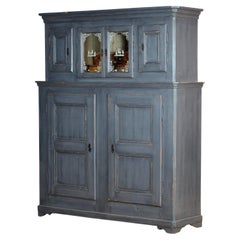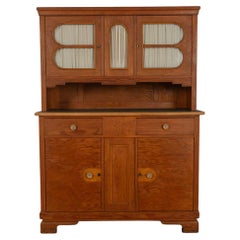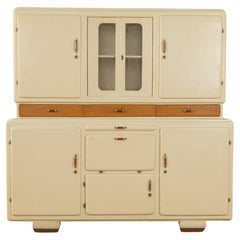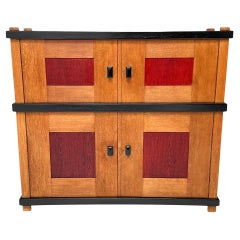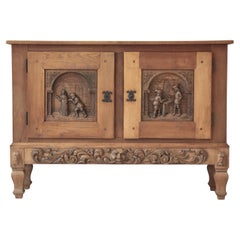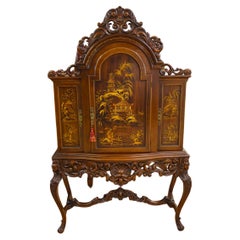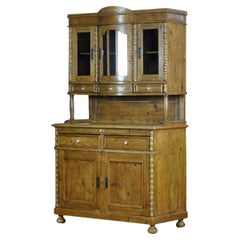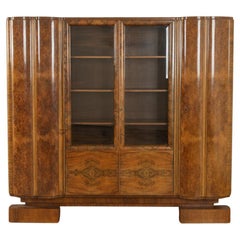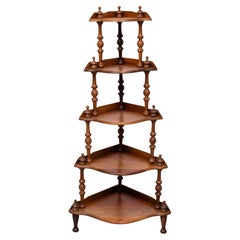1920s Kitchen Cupboard
Vintage 1920s Hungarian Rustic Cupboards
Glass, Pine
Vintage 1920s German Mid-Century Modern Cupboards
Glass, Wood, Formica
Vintage 1920s German Mid-Century Modern Cupboards
Glass, Wood
Vintage 1920s Dutch Art Deco Cupboards
Oak
Vintage 1920s Danish Jugendstil Cupboards
Oak
Vintage 1920s American Chinese Chippendale Cupboards
Walnut
Vintage 1920s German Rustic Cupboards
Glass, Pine
Vintage 1920s German Art Deco Cupboards
Glass, Wood, Walnut
Vintage 1920s English Victorian Corner Cupboards
Nutwood
Early 20th Century Spanish Spanish Colonial Cupboards
Walnut
Early 20th Century Spanish Spanish Colonial Cupboards
Walnut
Early 20th Century Spanish Spanish Colonial Cupboards
Walnut
Early 20th Century Spanish Spanish Colonial Cupboards
Walnut
Early 20th Century Spanish Spanish Colonial Cupboards
Walnut
Early 20th Century Spanish Spanish Colonial Cupboards
Walnut
Early 20th Century Spanish Spanish Colonial Cupboards
Walnut
Early 20th Century French Cupboards
Wire
Early 20th Century German Mid-Century Modern Cupboards
Glass, Wood
Vintage 1920s European Cupboards
Glass, Wood
Antique 1820s Hungarian Art Deco Corner Cupboards
Giltwood, Wood
Vintage 1920s Hungarian Rustic Cupboards
Antique 19th Century American Folk Art Cupboards
Wood
Vintage 1920s French Rustic Cupboards
Pine
Vintage 1920s Hungarian Rustic Cupboards
Glass, Pine
Vintage 1920s Hungarian Rustic Cupboards
Glass, Pine
Vintage 1920s Hungarian Rustic Cupboards
Glass, Pine
Vintage 1920s Hungarian Rustic Cupboards
Glass, Pine
Vintage 1920s Hungarian Rustic Cupboards
Porcelain, Pine
Vintage 1920s French French Provincial Cupboards
Glass, Pine
Vintage 1920s French Rustic Cupboards
Glass, Pine
Vintage 1920s Rustic Cupboards
Glass, Pine
Vintage 1920s Hungarian Rustic Cupboards
Pine
Vintage 1920s Hungarian Rustic Cupboards
Glass, Pine
Vintage 1920s Hungarian Rustic Cupboards
Glass, Pine
Vintage 1920s Hungarian Rustic Cupboards
Glass, Pine
Vintage 1920s Hungarian Rustic Cupboards
Pine
Early 20th Century English Jacobean Cupboards
Vintage 1920s Italian Mid-Century Modern Cupboards
Glass, Wood
Early 20th Century English Art Deco Cupboards
Walnut
Vintage 1920s French Cupboards
Leather, Wood
Vintage 1920s French Cupboards
Mahogany
Vintage 1920s Swiss Cupboards
Oak
Vintage 1920s German Industrial Cupboards
Steel
Vintage 1920s French Industrial Cupboards
Vintage 1920s German Industrial Cupboards
Steel
Vintage 1920s Dutch Art Deco Cupboards
Oak
Vintage 1920s German Industrial Cupboards
Steel
Vintage 1920s Belgian French Provincial Cupboards
Brass
Vintage 1920s German Industrial Cupboards
Steel
Vintage 1920s German Industrial Cupboards
Steel
Vintage 1920s British Queen Anne Corner Cupboards
Walnut
Vintage 1920s American Chinoiserie Cupboards
Brass
Vintage 1920s Danish Hepplewhite Corner Cupboards
Glass, Mahogany
Vintage 1920s German Industrial Cupboards
Steel
Vintage 1920s German Industrial Cupboards
Steel
Vintage 1920s German Industrial Cupboards
Steel
Vintage 1920s German Industrial Cupboards
Steel
Vintage 1920s French Cupboards
Brass, Iron
- 1
1920s Kitchen Cupboard For Sale on 1stDibs
How Much is a 1920s Kitchen Cupboard?
Finding the Right Storage-case-pieces for You
Of all the vintage storage cabinets and antique case pieces that have become popular in modern interiors over the years, dressers, credenzas and cabinets have long been home staples, perfect for routine storage or protection of personal items.
In the mid-19th century, cabinetmakers would mimic styles originating in the Louis XIV, Louis XV and Louis XVI eras for their dressers, bookshelves and other structures, and, later, simpler, streamlined wood designs allowed these “case pieces” or “case goods” — any furnishing that is unupholstered and has some semblance of a storage component — to blend into the background of any interior.
Mid-century modern furniture enthusiasts will cite the tall modular wall units crafted in teak and other sought-after woods of the era by the likes of George Nelson, Poul Cadovius and Finn Juhl. For these highly customizable furnishings, designers of the day delivered an alternative to big, heavy bookcases by considering the use of space — and, in particular, walls — in new and innovative ways. Mid-century modern credenzas, which, long and low, evolved from tables that were built as early as the 14th century in Italy, typically have no legs or very short legs and have grown in popularity as an alluring storage option over time.
Although the name immediately invokes images of clothing, dressers were initially created in Europe for a much different purpose. This furnishing was initially a flat-surfaced, low-profile side table equipped with a few drawers — a common fixture used to dress and prepare meats in English kitchens throughout the Tudor period. The drawers served as perfect utensil storage. It wasn’t until the design made its way to North America that it became enlarged and equipped with enough space to hold clothing and cosmetics. The very history of case pieces is a testament to their versatility and well-earned place in any room.
In the spirit of positioning your case goods center stage, decluttering can now be design-minded.
A contemporary case piece with open shelving and painted wood details can prove functional as a storage unit as easily as it can a room divider. Alternatively, apothecary cabinets are charming case goods similar in size to early dressers or commodes but with uniquely sized shelving and (often numerous) drawers.
Whether you’re seeking a playful sideboard that features colored glass and metal details, an antique Italian hand-carved storage cabinet or a glass-door vitrine to store and show off your collectibles, there are options for you on 1stDibs.
- 1stDibs ExpertNovember 2, 2021The best way to organize kitchen cupboards is by keeping in mind how you will use the contents. When you take a look at the items inside the cabinet, think about how frequently you use each item. Store the items you use most often in easy to reach locations — the front of the cabinet is best for an everyday item, or perhaps in canisters on the counter. The back of the cupboard, or higher shelves, should be reserved for items that you use less frequently. Shop a range of antique and vintage kitchen cupboards on 1stDibs.
- What is 1920s furniture called?1 Answer1stDibs ExpertNovember 13, 2024What 1920s furniture is called depends on its style. However, the most prominent design style of the decade was Art Deco. The term alone conjures visions of the Roaring Twenties, Machine Age metropolises, vast ocean liners, sleek typography and Prohibition-era hedonism. The iconic movement made an indelible mark on all fields of design throughout the 1920s and ’30s, celebrating society’s growing industrialization with refined elegance and stunning craftsmanship. Art Deco furniture often featured bold geometric lines, floral forms, shimmering mirrored finishes, sleek metal accents, and the use of expensive materials such as shagreen or marble as well as exotic woods such as mahogany, ebony and zebra wood. On 1stDibs, find a diverse assortment of Art Deco furniture.
- 1stDibs ExpertJune 15, 2023In the 1920s, fashionable colors included jewel tones. Fashion, jewelry, furniture and decorative objects often featured jade green, deep reds, amethyst purple, dusty mustard yellow and peacock blue. Find a range of 1920s-era jewelry and fashion on 1stDibs.
- 1stDibs ExpertMay 5, 2023In the 1920s, brides often wore tubular-shaped slip dresses with a beaded tunic over top. Hemlines usually fell just below the knee or to the ankle, and many gowns had dropped waists. For headwear, brides often showed off veils attached to cloche or flapper-style headbands. On 1stDibs, shop a collection of wedding dresses from some of the world’s top boutiques.
- 1stDibs ExpertApril 5, 2024The clothing style in the 1920s that most people think of first is the flapper style. Women who dressed in this style sported loose-fitting, short dresses, often outfitted with drop waists and fringe. Small cloche hats and headbands were signature accessories of the flapper look. During the decade, pleated tennis skirts and cardigan sweater sets left the courts and became staples of some women's everyday styles. For men, soft collars replaced stiff, starched ones, and simple single and double-button suit jackets worn without waistcoats became trendy. Trousers also took on a new shape with wider-cut legs, and Oxford bags gained popularity. On 1stDibs, shop a variety of 1920s apparel and accessories.
- What are 1920s dresses called?1 Answer1stDibs ExpertFebruary 13, 2023The iconic dresses from the 1920s are called flapper dresses. This name comes from the term flapper, which was used to describe young women during the period who enjoyed personal fulfillment and independence in American cities, particularly as they gained the right to vote and enjoy other freedoms previously reserved for men. Flappers danced at jazz clubs and upended most societal restrictions placed on women at the time, and fashion statements typically attributed to flappers included short “bob” haircuts, higher hemlines and other then-audacious style choices. Find a selection of flapper dresses on 1stDibs.
- What era is 1920s jewelry?1 Answer1stDibs ExpertDecember 4, 2023What era 1920s jewelry is depends on its design. Most people associate this decade with the Art Deco movement, which took inspiration from eclectic sources like Cubism, ancient Egypt and Native American, African and Asian motifs. However, some pieces produced during the 1920s are more in line with the style trends of earlier periods, such as Art Nouveau, Edwardian and Victorian. Explore a diverse assortment of 1920s jewelry on 1stDibs.
- What do I wear to a 1920s party?1 Answer1stDibs ExpertMarch 3, 2023To a 1920s party, you can wear a short fringed or beaded flapper dress, layers of long beaded or pearl necklaces, elbow-length gloves and a feathered headband. Another option is to wear an off-white men's suit. Shop a selection of vintage apparel on 1stDibs.
- 1stDibs ExpertMarch 22, 2022In the 1920s, flappers often wore straight, fitted dresses with plunging necklines and knee-length hems. Fringe was a common embellishment used at the time. Flappers also sported pumps and opted for bras and lingerie instead of corsets for undergarments. Shop a variety of vintage clothing on 1stDibs.
- 1stDibs ExpertMay 5, 2023The type of tile that was used in the 1920s was primarily ceramic. Many shapes were available, including basketweave, penny round, pinwheel, square and subway. Hexagon tiles, however, which are still on trend, have been in use in bathrooms since at least the early 1900s. The choice of hexagonal tiles is believed to have been tied to cleanliness, as the small pieces could stand up to aggressive cleaning and could be easily replaced if needed. On 1stDibs, shop a collection of tiles from some of the world's top sellers.
- 1stDibs ExpertApril 5, 2022Flapper dresses from the 1920s came in a range of colors, although darker hues such as black and navy were immensely popular. Flapper dresses were cut with straight and slim silhouettes, were typically knee-length and had a lower neckline. They were often made from silk chiffon and featured beaded details. You’ll find a selection of 1920s flapper dresses from some of the world’s top sellers on 1stDibs.
- 1stDibs ExpertNovember 21, 2023In the 1920s, engagement rings still looked like rings but were representative of a diverse range of styles and influences. Art Deco diamond ring designs took inspiration from the contemporary Cubist movement as well as from ancient Egypt – a revival sparked by the opening of King Tut’s tomb in 1922. Native American, African and Asian motifs also inspired jewelry pieces. Diamonds in square and rectangular shapes incorporating angular steps – like emerald cuts, Asscher cuts and baguettes – were set against black onyx, rubies, sapphires and emeralds to create color-blocking effects. Platinum, 18-karat gold, 14-karat white gold and sterling silver were some of the favored metals of the decade. Find a wide range of Art Deco engagement rings on 1stDibs.
- 1stDibs ExpertJanuary 10, 2025Coco Chanel was considered one of the leading fashion designers in the 1920s and ’30s in Paris. The first Chanel shop was established in 1910 on rue Cambon by the young milliner Gabrielle Chanel, who had picked up the nickname “Coco” while working as a club singer. The boutique drew the attention of the Parisian fashion elite, who popularized her wide-brimmed Chanel Modes hats. Soon, she added a sportswear store in the Normandy resort town of Deauville, where Coco set the tone for her defining sense of style — traditionally masculine garments reimagined for feminine shapes, made from simple jersey fabric. Effortless and elegant, Chanel's designs promoted comfort and grace in women’s wear that had been dominated in the previous century by complicated layers of fabric and cumbersome corsets. She followed this success with a couture house, opened in 1915 in Biarritz. In 1926, Chanel introduced her first little black dress, reclaiming a color that had once been reserved for mourning and working-class women. That same decade, she debuted her perfume, Chanel No. 5, as well as the Chanel suit with a fitted skirt, inspired by the boxy lines of men’s clothing and employing a sporty tweed. During the 1920s, she also unveiled the predecessor for the 2.55 Flap bag, which remains one of Chanel's most popular offerings. Shop a large selection of Chanel apparel, bags and accessories on 1stDibs.
Read More
The Ultimate Guide to Types of Tables for the Home
Whether you’re just moving in or ready to give your home a makeover, our guide will give you pointers on tables that are fitting for every room, nook and hallway.
What Exactly Is a Secretary Desk, and What Is It Used For?
The furniture equivalent of a Swiss Army knife, it's the multifunctional piece you didn't know you needed.
This Shelving System with Oxidized Brass Tubes Is Retro and Futuristic at Once
Italian studio DimoreMilano mustered great ingenuity when crafting these sculptural shelves, which are built without any screws.
28 Cheerful Home Bars, Where Everybody (Literally) Knows Your Name
Simple or sophisticated, equipped with console, cart or custom cabinetry, these stylish bar areas deserve a toast.
Ask an Interior Designer: Work-from-Home Edition
Leaping into a design project, whether it's refreshing the bedroom or redoing the whole house, can be overwhelming. Luckily, we know more than a few interior designers. You asked questions on Instagram, and now they're answering.
Collected and Eclectic, ‘Wunderkammern’ Are Back in a Big Way
Introduced nearly 500 years ago, curiosity cabinets are finding new fans among today's collectors and designers.
Meet the Incredible Woman Transforming Fallen Trees into Sleek Furniture
In the hands of New York Heartwoods cofounder Megan Offner, unwanted local trees become works of design art.
These New York Architects Love a Complicated Project
From Brooklyn townhouses to Maine campgrounds, Trattie Davies and Jonathan Toews relish a challenge, like transforming a former warehouse space into the new 1stdibs Gallery.
